|
Chorale Melodies used in Bach's Vocal Works
Christ ist erstanden |
|
Melody & Text | Use of the CM by Bach | Use of the CM by other composers | Footnotes |
| |
|
Melody & Text: Zahn: 8584 | EKG: 75 |
|
Origins: |
|
This chorale is based upon the original Latin Easter sequence [1] Victimae paschali / laudes immolent Christiani, [2] [see: Wipo: Easter sequence (c1040)] the origin of which can be traced back to Wipo of Burgundy (c. 990 until after 1048), dated c. 1040, and which was then later, in the 12th century transformed into a Leise [3]. During the ensuing centuries before the Reformation, additional verses (up to a total of 3) were gradually added. This Leise then underwent a substantial transformation by Martin Luther (1483-1546) with the help of Johann Walter. In this version, the chorale, as it is known today, first appeared in print in an edition by Joseph Klug, Wittenberg, 1533.
For the purpose of comparison between the earliest stage [Wipo] and Luther’s borrowing from the Leise tradition, here is a score sample tracking the similarities: |
|
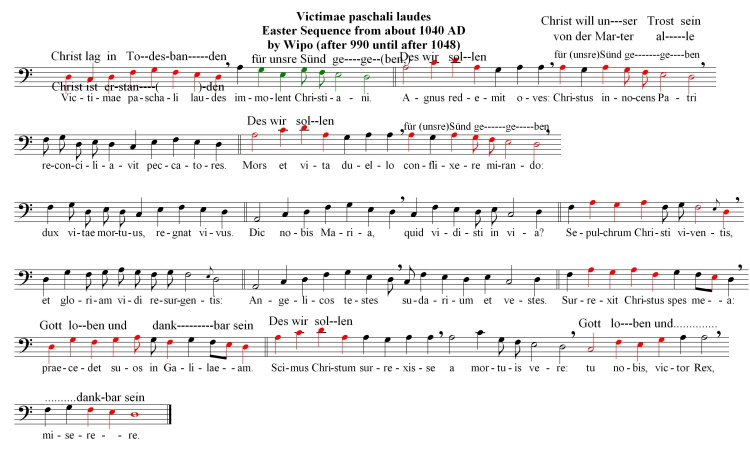
|
|
It is possible to track many of the stages between the earliest and later stages of development and transformation:
1. From a 13th century manuscript containing a section of the liturgy entirely in Latin with the exception of the phrase “Christ ist erstanden” which incidentally has a form of musical notation explained below and stands before the Te deum. |
|

|
|
2. In this 14th-century manuscript (1325), there is this oldest version of what will eventually become the 1st verse of Christ ist erstanden complete with neumes to indicate how the text should be sung. The German text is repeated in Roman type below to aid in deciphering the text. |
|

|
|
3. From 1479, here is a two-part setting of Christ ist erstanden in recognizable musical notation. [The latter 3 examples are taken from the MGG1, Bärenreiter, 1986] |
|
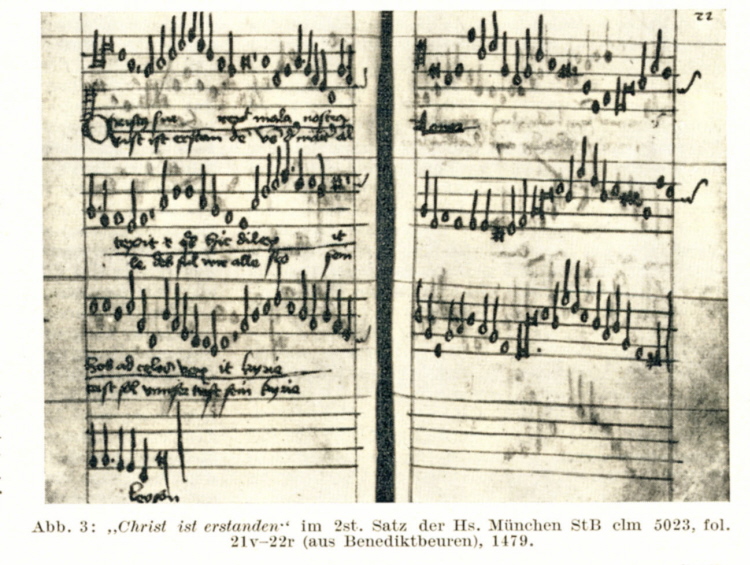
|
|
4. The popularity of Christ ist erstanden is documented by its appearance in 3 separate settings in the Glogauer Liederbuch (c1480) which contains primarily secular settings of popular compositions. One of these settings appears with a different melody and a slightly changed title as well: |
|
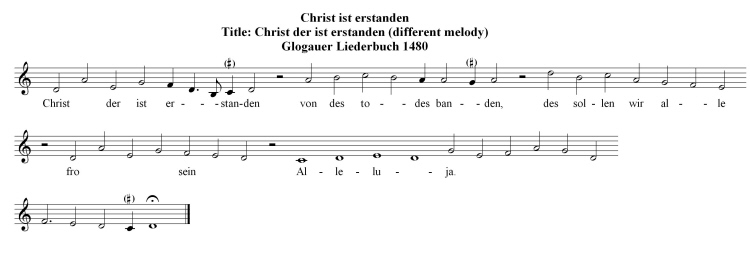
|
|
However the other two serve as prime examples from the period more directly preceding Luther’s adaptation and transformation of this melody. Here is the complete version of the melody: |
|

|
|
A much abbreviated and changed shorter version with a slightly different title also appears in this collection: |
|

|
|
Remarkably, the same collection contains a Latin version of the German Leise as a quasi backformation of the original Wipo version: |
|
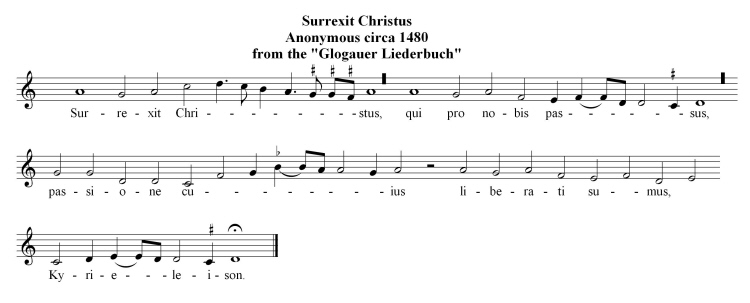
|
|
An odd item which probably does not belong here, but which is mentioned as a Russian version of Christ ist erstanden from Smolensk in an article from the MGG1 is probably based solely upon the German translation of a similar phrase (Christ has/is arisen) used in an old Russian folksong that finds its way into Strawinsky’s Petrouchka via Tschaikovsky’s collection of folksongs (1877).
|
|

|
|
For the musical notation and text of the Easter sequence on which Christ ist erstanden is based, see: Wipo: Easter sequence (c1040) |
|
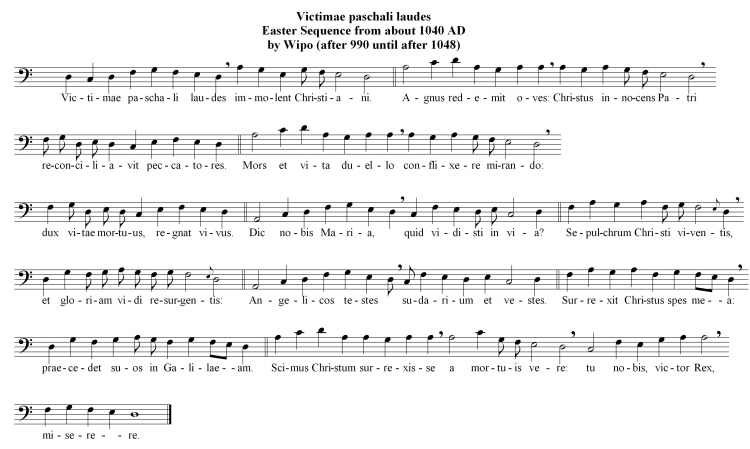
|
|
A rough translation of the Latin yields the following:
“Christians, dedicate your songs of praise to the victim of Easter. The lamb which saves the sheep: Christ innocently has brought sinners to be reconciled with the Father. Death and life were engaged in a strangely wild contest with each other: the Living One who died is now the living ruler.” [turning directly to Maria:] “Tell us, Maria, what did you see on your way here?” Maria answers:] “I saw the grave of Christ, the Living One. I saw the splendor of the Arisen One: the host of angels gave witness as well as the sudarium and the linen. My hope, Christ, has arisen and goes ahead of you to Galilee.” Truly, Christ has risen from death. Have mercy upon us, victorious ruler!
For a more detailed explanation on how German texts appeared in the middle of Latin sequences and later were extended into sacred songs, Leisen, with a number of verses, and how these Leisen served as the basis of some of Martin Luther’s most important hymns, here is a portion of an article on this subject from the Grove Music Online: |
|
>> The early Christian church provided a number of opportunities for congregational participation. The Ambrosian hymns were originally intended to be sung by the congregation, and congregational refrains were added to a number of liturgical chants. From the 6th century liturgical singing became the preserve of the cantor and choir. But extra-liturgical songs in the vernacular continued to be written and sung at principal festivals, some saints’ days and, later, in connection with liturgical drama. Throughout the Middle Ages the refrain ‘Kyrieleison’ was sung as part of the litany as well as after the Latin strophes of such hymns as the Te Deum or after the individual verses of psalms. By the Carolingian period, the ‘Kyrieleison’ refrain was frequently extended with short vernacular phrases, and German translations of the Latin hymn strophes themselves began to appear. The oldest surviving example is an Old High German version of the Latin hymn Aurea luce, the so-called ‘Freisinger Petrus-hymnus’ , in an early 9th-century neumed manuscript. Such vernacular hymnody was particularly strong in German-speaking regions. Between the 9th century and 1518 over 1400 German vernacular hymns are known to have been written. The hymn of Hussite Bohemia, the English medieval carol and the Italian lauda are comparable repertories of this period.
From the 12th century the principal forms of vernacular singing that developed into the Reformation chorale were German translations of Latin chant, the Leise (German spiritual song) and the cantio (Latin spiritual song). Of all the forms of Gregorian chant, medieval translators understandably favoured the Ambrosian hymn of the monastic Offices with its short strophes, concise and straightforward language and essentially syllabic melodic style. These qualities later made it the most significant Gregorian source for the Protestant chorale writers. Single hymns such as the ‘Petrus-hymnus’ and even entire hymnaries were translated; but during the later Middle Ages hymns for the principal feasts were strongly preferred. Two of the most important German translators of the period, the Monk of Salzburg and Heinrich Laufenberg, set important precedents for Reformation poets with their choice of hymns as well as their translations. Late medieval hymn translations were rarely provided with musical notation, but the fact that they kept the original metrical schemes suggests that they were meant to be sung to the original melodies; the presence of rubrics suggests that they may have been used occasionally in some forms of liturgical worship.
Apart from the hymns, the chants for the Office did not as a group stimulate many translations, but individual antiphons such as Media vita in morte sumus, formerly attributed to Notker Balbulus, and the 11th-century Pentecost antiphon Veni Sancte Spiritus existed in the German versions Mitten wir im Leben sind and Komm, heiliger Geist, Herr Gott from at least the early 15th century. The chants for the Mass having non-strophic texts and relatively intricate melodies did not encourage translation in the pre-Reformation period, particularly since they remained the exclusive province of the clergy and choir. There were isolated translations of some items,however, such as a 15th-century German metrical rendering of the Credo, Wir glauben in einen Gott , which served as one of several sources for Luther’s Wir glauben all an einen Gott . Of the Propers only the sequence assumed considerable, indeed outstanding, importance for the later history of the chorale as the origin of the Leise.
During the late Middle Ages the practice developed of occasionally permitting the congregation to sing German versions of the sequence (itself by this time a metrical, strophic form) during the regular service at the principal feasts of the church year, immediately after the clergy and choir had performed the Latin original. These German strophes typically concluded with the refrain ‘Kyrieleis’ and thus suggested the name Leise for the genre, a name which was soon applied to other refrain songs as well. Most Leisen have a single strophe of four short lines, a simple melody often consisting of repeated motivic formulae and the ‘Kyrieleis’ refrain. Generally a Leise strophe retained the same melody throughout the centuries while the refrain continually received new settings, invariably of the simplest melodic material.
Since the Leise shares stylistic and liturgical elements with the litany, the Kyrie, the hymn, the sequence and the folksong, its origins and development have been a matter of controversy. The picture is complicated by the fact that whereas there was an outburst of production of Leise texts between the 12th century and the early 14th, melodies for them are extant only from the 15th century. The most important and well-known Leisen , those which survive in Protestant chorales, have particularly strong musical and even liturgical connections with the sequence. The chorales associated with the major feasts as listed below , the opening strophes of which existed as Leisen in the Middle Ages, all substantially derive their melodic material from the Latin sequence for the same feast. Chorales included in the standard hymnbook of the present German Lutheran church, the Evangelisches Kirchen- Gesangbuch (E KG), are cited by their number in that volume.
Most of these Leisen appear with the corresponding Latin sequence in medieval liturgical manuscripts, and because of that they are now thought to have developed as abbreviated forms of the Latin sequence. According to this interpretation the concluding ‘Kyrieleis’ refrain, with its variable melodies, assumes only secondary importance, whereas earlier views suggested that the four-line strophe was appended to the original acclamation.
[This is the order according to which the following list is organized: Feast, Leise, EKG, Sequence]
Christmas | Gelobet seist du Jesu Christ (14th century)| EKG: 15 | Grates nunc omnes reddamus
Easter | Christ ist erstanden (12th century) | EKG: 75 | Victimae paschali laudes
Pentecost | Nun bitten wir den heiligen Geist (13th century) | EKG: 99 | Veni Sancte Spiritus (Hypolydian version)
Corpus Christi | Gott sei gelobet und gebenedeiet (14th century) | EKG: 163 | Lauda Sion Salvatorem
In addition to these ‘liturgical’ Leisen there were others whose origins were closer to that of folksong, being associated with less formal aspects of medieval religious life such as liturgical dramas, processions and pilgrimages. The best-known is probably the 13th-century crusaders’ Leise: In Gottes Namen fahren wir, the melody of which is sung to a hymn of the same title ( EK G 388 ) and to Martin Luther’s Dies sind die heilgen zehn Gebot (EKG 2 40). The melodies of such ‘popular’ Leisen show some preference for the Mixolydian mode.
The cantio, a non-liturgical but sacred Latin unison song that was cultivated from the 14th century, largely in monastic and literary circles, is clearly related both to Latin liturgical hymnody and to the Leise. Cantiones often originated in connection with the liturgical dramas for Easter and Christmas (e.g. In natali Domini, Puer natus in Bethlehem, Surrexit Christus hodie) and were otherwise generally associated with Advent and Christmas. Many cantiones were translated into German long before the Reformation and were frequently sung antiphonally, particularly in Germany and Bohemia, with alternating Latin and German verses. A number of these mixed-language song pairs such as Surrexit Christus hodie – Erstanden ist der heilig Christ (EKG 78) and the completely macaronic In dulci jubilo – Nun singet und seid froh (EK G 26), with alternate Latin and German lines, were appropriated unchanged into the Reformation hymnbooks and are included in the Evangelisches Kirchen- Gesangbuch in German versions alone. With their major-mode melodies and frequently strong dance rhythms, often in triple metre, the cantiones show the considerable influence of medieval folksong and dance.<<
From an article by Robert L. Marshall and Robin A. Leaver in the Grove Music Online, Oxford University Press, 2006, acc. 2/4/06.
|
|
For further definitions as given in the Grove Music Online, see: Leise [3], Ruf [4].
Not only did Martin Luther use the Leise Christ ist erstanden for his version of a chorale by the same name, but he also employed certain portions of the melody for another similar hymn Christ lag in Todesbanden. His efforts applied in this direction are detailed quite well in another article in the Grove Music Online: |
|
>> Few people, and even fewer events, had such an impact on Germany as Martin Luther and his Reformation. Aside from causing religious, political and socio-economic upheaval, it was of musical significance in that the role of music was redefined both in terms of the Lutheran service and the Christian way of life in general. Unlike the Swiss reformers Zwingli and Calvin, who either banished music altogether or restricted its use in their reformed services, Luther saw music and theology as inextricably woven together. In keeping with his principle of congregational participation, his main vehicle for the delivery of the Word of God was the Protestant hymn, which was to be sung in the vernacular to simple, tuneful melodies. For his texts Luther resorted chiefly to Roman Catholic hymns, which he (or his collaborators) translated into German. These included Nun Komm der Heiden Heiland , a reworking of the Veni Redemptor gentium , and Komm Heiliger Geist , a translation of Veni sancte spiritus . Aside from capitalizing on a well-known Latin repertory, Luther relied heavily on the German folk tradition. Gelobet seist du, Jesu Christ and Nun bitten wir den Heiligen Geist were either altered or considerably extended by Luther, whilst the famous 11th-century hymn Christ ist erstanden was completely rewritten to form Christ lag in Todesbanden . Luther also created newly composed hymns such as Nun freut euch, lieben Christen g’mein and Ein’ feste Burg ist unser Gott . By 1523 broadsheets containing German hymns complete with melodies were printed in Wittenberg. In 1524 the ‘Achtliederbuch’ , a collection of 40 monophonic hymns, over half of which were written by Luther himself, was issued in Nuremberg. This important publication was soon followed by numerous others which appeared not only in Nuremberg and Wittenberg, but also in Leipzig, Strasbourg, Worms and Erfurt. Although the Protestant chorale was conceived as a monophonic tune, it was quickly reworked into polyphonic settings by Johann Walter who, working closely with Luther and the Wittenberg printer Georg Rhau, published the first polyphonic collection of Luther’s hymn repertory (Geystliches gesangk Buchleyn , 1524).<<
From an article by Robert L. Marshall and Robin A. Leaver in the Grove Music Online, Oxford University , 2006, acc. 2/4/06.
|
|
Neume - one of a set of signs employed in the earliest plainsong notation to indicate the melody. For example of these markings between the lines of text, see:
13th century manuscript. |
|
This example, taken from the MGG1 (Bärenreiter, 1986), from the 13 th century shows a portion of the Latin Easter liturgy before the Te Deum with the insertion of the neumed German text for Christ ist erstanden indicating that this part was sung approximately according to the notational indications.
From articles by Walther Lipphardt in the MGG1 (Bärenreiter, 1986), we can obtain the following information (a summary translation of pertinent sections follows): |
|
der Leis or Leise : a technical term for a category of spiritual/sacred folksong s that began their development as refrain-like responses or additional phrases that were sung at the end of certain Latin sequences that were part of the church services in the late Middle Ages.
The most valuable contribution of the German Middle Ages to the origin of chorale singing by church congregations is the development of the Leis or Leise. This development took place between the 12th and 14th centuries. Still being disputed is the manner in which the acclamations ( Rufe - short verbal responses by the congregation) were transformed and expanded into to musical responses/cadences, then into 2-line and later 4-line verses in the vernacular language (this taking place within the Ordinary of the Mass which was entirely in Latin) and whether these Leisen were simply abbreviated Latin sequences which were subsequently translated into the vernacular and sung by the congregation in the same way that the final “Kyrie eleison” was sung as “Kyrieleis” by German speaking congregations. [The term Leis or Leise is derived from the latter German corruption of the original Greek.]
The ‘classical’ form of the Leise of the late Middle Ages consists of an extremely primitive and common rhyming couplet that can be extended at will: …C C D D… It is unlikely that this pattern gave the original impetus for the wide-spread growth of the Leise. Since the connection to the sequences used in the liturgy can be so clearly demonstrated, most scholars accept this as the most obvious origin of the Leise. This relationship between the Leisen and the sequences is found in a number of instances, of which an important example is Easter Leise Christ ist erstanden. The latter derives its musical material from the 1st , 2nd and last lines of the sequence Victimae paschali laudes. [Similarly Veni Sancte Spiritus becomes Nun bitten wir den Heiligen Geist , Lauda Sion becomes Gott sei gelobet und gebenedeiet; Jesse virgam humidavit becomes Nun sei willekommen; and Grates nunc omnes becomes Gelobet seist du, Jesu Christ.]
These Leisen are all songs which were created and sung as interpolations within the Latin sequences for special feast days such as Christmas and Easter. The incentive for this probably can be traced back to a Parisian church model in which the Easter celebration included a nocturnal dramatic presentation that took place before the Te Deum. [K. Young , in “The Drama of the Mediaevel Church”, provides 130 separate sources between the 12th and 16th centuries to document this procedure.] In Germany, the earliest documentation of such an Easter celebration including the Christus ist erstanden comes from an Augustinian Convent (St. Forian?) in Passau. This Leise is the oldest and the most popular one that was still used in such Feast day liturgies into the middle of the 16th century. Around 1500, this Easter sequence with its German interpolation can be documented in use in Diessen, Augsburg, Breslau, Bamberg, and Wrzburg. Around this time, the Cathedral of Salzburg had, as part of the Latin sequence used in its Easter Vespers, a processional during which the congregation sang not only the 1st verse of Christ ist erstanden but also the 2 nd verse “Wنr er nicht erstanden” and also the 3-fold “Alleluia”. [Although of a different origin and development, the English carol, in its earliest stages, also involved processional singing of the carols, but these processionals took place outside of the church building and were not directly integrated into the church liturgy.]
The Leisen from the 14th and 15 th centuries not only were of very important liturgical significance, but they were also very popular among lay populace which attended the services. Proof of their importance is found in the numerous polyphonic settings of these Leisen during the two centuries before the Reformation.
|
| |
|
Sources/Pre-Bach Settings: |
|
A hymnal source with which Bach may have been acquainted:
Christ ist erstanden as it appears in the Gotha hymnal from 1715. |
|
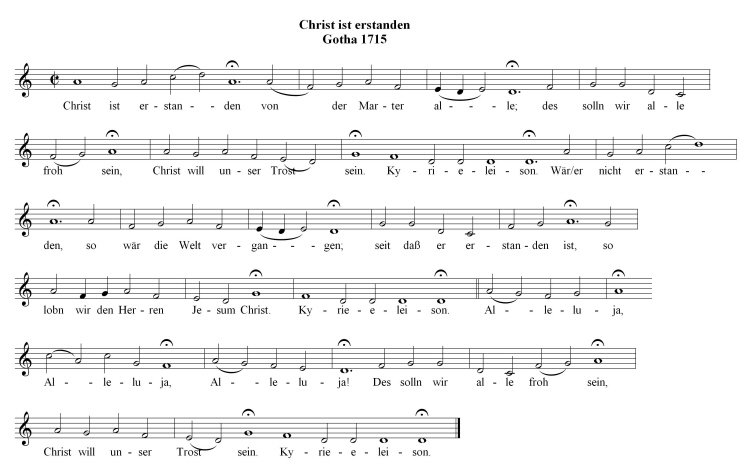
|
|
Some important sources/settings of the Luther chorale from the pre-Bach period worth examining are the following:
1. Heinrich Isaac: Setting |
|

|
|
2. Wittenberg, 1533 |
|
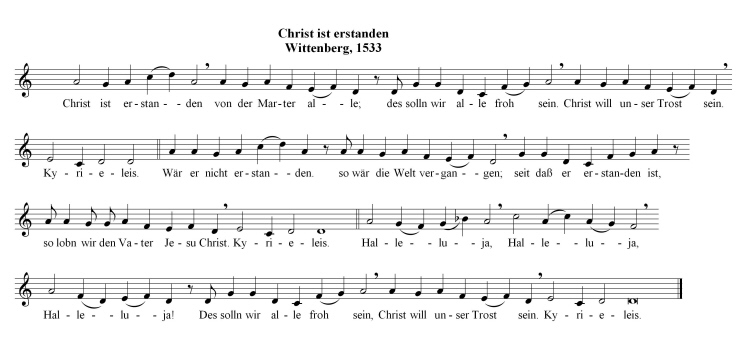
|
|
3. Ludwig Senfl: Setting in "Neue deutsche Gesenge (Wittenberg, 1544) |
|

|
|
4. Sixt Dietrich: 4-pt. setting (1545) |
|
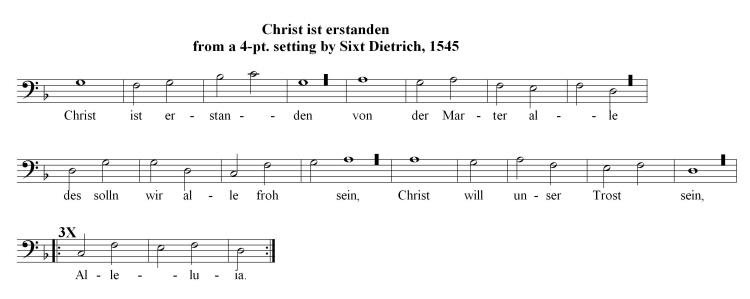
|
|
5. Johann Walter: Setting from "Wittembergisch deudsch geistlich Gesangbüchlein" (1551) |
|

|
|
6. Leonard Lechner: 4-pt. setting (1577) |
|

|
|
7. Johann Eccard: Setting for 5 voices (1578) |
|

|
|
8. Orlando di Lasso: 4-pt. setting (1583) |
|

|
|
9. Hans Leo Hassler: 4-pt. setting (1608) |
|

|
|
10. Samuel Scheidt: Setting (Görlitz, 1650) |
|
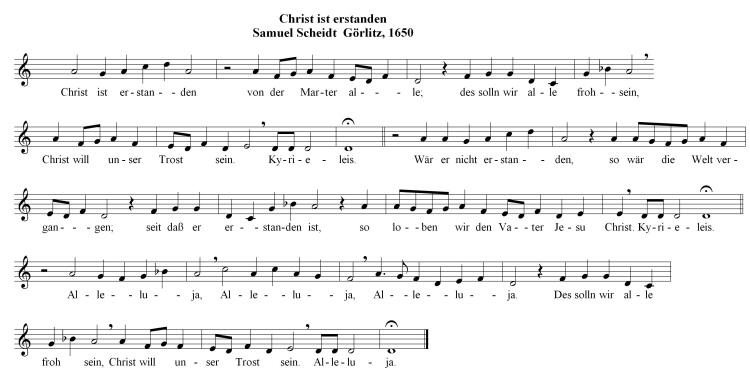
|
| |
|
Other associated CM's: |
|
The CM Christ lag in Todesbanden (Zahn: 7012a; EKG: 76), although not the same as the chorale Christ ist erstanden in the Luther version, has a common origin and has undergone a similar transformation.
The CM Christus ist erstanden, hat überwunden (Zahn: 6240c) is not to be confused with the CM “Christ ist erstanden” as this has an entirely different melody and unknown origin. |
| |
|
Use of the Chorale Melody by Bach: |
|
Text: Christ ist erstanden | EKG: 75
Author: Martin Luther (1533) |
|
Ver |
Work |
Mvt. |
Year |
Br |
RE |
KE |
Di |
BC |
Score |
Music Examples |
|
3 |
BWV 66 |
Mvt. 6 |
1724 |
- |
37 |
- |
79 |
A56:6 |
PDF |
Mvt. 6 (MG) [midi] | Mvt. 6 (Leusink) [ram] |
|

|
| |
|
Untexted: |
|
Ver |
Work |
Mvt. |
Year |
Br |
RE |
KE |
Di |
BC |
Score |
Music Examples |
|
- |
BWV 276 |
- |
? |
197 |
36 |
197 |
- |
F25:1 |
PDF |
Chorale [midi] |
|
- |
BWV 627 |
- |
1713/15 |
- |
- |
- |
- |
K57 |
- |
|
|

|
|

|
| |
|
Use of the Chorale Melody by other composers: |
|
Guillaume Dufay (1397-1474):
Missa ‘Christus surrexit’ for 4 voices attributed to Dufay using Christ ist erstanden as the cantus firmus |
|
Johannes Brassart (c1400-1455):
Setting of Christ ist erstanden for 3 voices |
|
Heinrich Finck (1444/1445-1527):
A motet-like setting of Christ ist erstanden
The two sacred pieces Christ ist erstanden and In Gottes Namen fahren wir resemble motets in their size and scope and strong cantus firmi |
|
Hans Judenkönig (c1445-50 - 1526):
Intabulation for lute on the hymn Christ ist erstanden (1523) |
|
Heinrich Isaac (c1450-55 - 1517):
Setting of the sacred song Christ ist erstanden. See: Score |
|
Thomas Stoltzer (c1480-1526?):
Christ ist erstanden, Setting for 4 voices |
|
Stephan Mahu (1480-1490 - 1541?)
Christ ist erstanden, Setting for 5 voices (1544) |
|
Ludwig Senfl (c1486-1543):
Christ ist erstanden, Settting for 6 voices (1544). See: Score |
|
Johannes Galliculus (c1490-c1550):
Easter Mass (1539) containing melodic and textual materials from Christ ist erstanden |
|
Sixt Dietrich (c1492-1648):
Christ ist erstanden, 4-pt. setting (1545). See:
Score |
|
Matthias Greiter (c1494-1550):
Christ ist erstanden, Motet for 5 voices |
|
Johann Walter (1496-1570):
Christ ist erstanden, for 4 voices
Christ ist erstanden, Setting for 5 voices |
|
Johannes Heugel (before 1500 - 1585):
Five settings of Christ ist erstanden for 6 to 8 voices (1537-1544) |
|
Jörgen Presten (?? - 1553):
Christ ist erstanden, 2 motets on for 6 and for 8 voices |
|
Arnold von Bruck (1500 (?) - 1554):
Christ ist erstanden, Setting for 4 voices (1544) |
|
Johann Knöfel (1525-30 - 1617):
Christ ist erstanden, Motet for 6 voices |
|
Hermann Finck (1527-1558):
Christ ist erstanden,Motet for 5 voices |
|
Orlando di Lasso (c1532-1594):
Christ ist erstanden, Setting for 4 voices (1583). See: Score |
|
Caspar Copus (fl c1550 ):
Cantus firmus of Christ ist erstanden is used in one of his settings of the Proper. |
|
Leonard Lechner (1553-1606):
Christ ist erstanden, 4-pt. setting (1577). See: Score |
|
Johann Eccard (1553-1611):
Christ ist erstanden, Setting for 5 voices (1578). See: Score |
|
Karl Regnart (flourished c1563):
Missa super Christ ist ersta nden |
|
Thomas Mancinus (1550-1611/1612):
Christ ist erstanden, Setting for 5 voices |
|
Hans Leo Hassler (1564-1612):
Christ ist erstanden for 4 voices (1608). See: Score |
|
Heinrich Schütz (1585-1672):
Christ ist erstanden von der Marter alle, S, A, T, 4 viole [III lost], 4 trbn, [2 cap. a 4], bc (+ lutes, org piccolo, org grande), Kl 52b [1614–15; bc and lute are autograph] (variant sinfonia in late bc part), SWV 470 [c1650] |
|
Johann Hermann Schein (1586-1630):
Christ ist erstanden, SATB [bc] (1627) |
|
Samuel Scheidt (1587-1654):
Two settings of Christ ist erstanden:
1 Soprano (and bc?), SSWV 462. See: Score
STB bc from Geistlicher Concerten … dritter Theil, SSWV 308 (Halle, 1635) |
|
Augustin Plattner (birth and death dates unknown; active years 1613-1624):
Parody Mass in which the melody Christ ist erstanden appears |
|
Johann Pachelbel (1653-1706):
Cantata for one voice and instruments Christ ist erstanden (lost) |
|
Johann Friedrich Doles, sr.(1715-1797):
Christ ist erstanden Cantata for Choir, Soloists, and Orchestra |
|
Georg (von) Reutter (i) (1656-1738):
Canzona on Christ ist erstanden is probably by Nicolaus Adam Strungk |
|
Georg Philipp Telemann (1681-1767):
Church Cantata Christ ist erstanden (Neumeister), TWV 1:136 (1722) |
|
Caspar Ett (1788-1847):
Christ ist erstanden for 4 voices , strings, 2 Oboes, 2 Horns, 2 Trumpets , 2 Trombones, and Organ |
|
Theophil Forchhammer (1847-1923):
Over 40 different settings of Christ ist erstanden for liturgical use |
|
Richard Bartmuß (1859-1910):
Christ ist erstanden, Chorale Fantasia for organ |
|
Hermann Grabner (1886-1969):
Fantasia on Christ ist erstanden for organ (this entry from the MGG1 has listed 5 settings) |
|
Petros Petridis (1892-1977):
Christ ist erstanden for string orchestra (1943) |
|
Paul Müller-Zürich (1898-1993):
Chorale Fantasia on Christ ist erstanden for organ, 2 trumpets and trombone |
|
Robert Blum (1900-1994):
Christ ist erstanden, for orchestra (1962) |
|
Joseph Ahrens (1904-1997):
Christ ist erstanden, Organ Partita (1935) |
|
Raimund Weißensteiner (1905-1997):
Christ ist erstanden , Symphonic Meditations f or Orchestra (1961) |
|
Richard Purvis (1913-1994):
Partita for organ on Christ ist erstanden |
|
Jürg Baur (1918-2003):
Choral-Triptychon on Christ ist erstanden (1970) |
Alan J. Wilson (b 1947):
Christ is now risen again for
SATB & organ. - Medieval hymn translated by Bishop Miles Coverdale
(1487-1569), adaptation of 12th century melody Christ ist
erstanden (1979, Addington Press, RSCM / Mowbrays)
Contributed by Daniel Prejean (May 10, 2009)
|
| |
|
Footnotes |
|
[1] A sequence is the oldest and most important type of trope [Trope is a generic term for the textual additions made to the authorized text for the Ordinary of the Mass as set down by Pope Gregory I. OED: trope: In the Western Church, a phrase, sentence, or verse introduced as an embellishment into some part of the text of the mass or of the breviary office that is sung by the choir. – Tropes were discontinued at the revision of the missal under Pope Pius V in the 16th century. ] A sequence is an accretion to the alleluja and is usually called an alleluja trope. [OED: sequence : a composition in rhythmical prose or accentual meter said or sung, in the Western Church, after the Alleluia and before the Gospel. Sometimes called a prose.] It is textually in the form of a long poem with the rhyming pattern beginning and ending with a single line: a, b b, c c, d d, …g g, h. There is no clear relationship between the melody of the alleluja and the newly added material.
Grove Music Online, Oxford University Press, 2006, acc. 2/8/06
[2] Victimae paschali laudes
(Lat.: ‘praises to the paschal victim’)
The sequence for Easter (LU, 665; HAM, no.16 a). The text is ascribed to Wipo of Burgundy ( died c1050). It was one of the four sequences retained by the Council of Trent (1545– 63), following which the first part of the final double versicle, containing an uncomplimentary reference to the Jews, was normally omitted. It occupies a position midway between the early type and that of Adam of St Victor ; there is some rhyme, but the metre is still very irregular even though it was not apparently written to a pre-existing melody. It was frequently incorporated into liturgical dramas at Easter. There is a primitive organum setting in the Las Huelgas manuscript (E-BUhu ; early 14th century), and an anonymous 15th-century alternatim setting survives in Trent (I-TRmnp 88). In addition there are settings by Busnoys, Josquin (two), Willaert (two), Lassus, Palestrina (four), Victoria (an incomplete setting beginning at ‘Dic nobis’ ), Fernando de las Infantas and Byrd. It was used as a cantus firmus in Isaac's setting of a different Easter sequence, Laudes Salvatori , and there is a partial setting, beginning at ‘Agnus redemit oves’, in Johannes Hنhnel's Easter Mass. This latter is largely based on the German tune Christ ist erstanden, itself derived from parts of the plainsong of Victimae paschali , from which it was absorbed into the stream of Lutheran melodic style for the Calvinist use of the tune.
John Caldwell in Grove Music Online, Oxford University Press, 2006, acc. 2/8/06
[3] Leise
(Middle High Ger. Leis ).
A devotional, Germanic song stanza in the nature of a refrain, found particularly in the later Middle Ages. Supposedly deriving its name from the words ‘Kyrie eleison’ as they appear repeatedly in the l, the Leise is normally considered a part of the general category Ruf (acclamation) and is distinguished within that category by being characteristically in a four-line form without musical repeats. The earliest known example is thought to be the 9th-century Freising song to St Peter, Unsar trothîn hât farsalt ( D-Mbs Clm 6260, f.158 v ). In the early stages of specifically German polyphony (beginning with the lost early 15th-century Strasbourg manuscript F-Sm 222) Leisen were often set; other examples include Christ ist erstanden (based on the opening of the sequence Victimae paschali laudes and traced to the mid-12th century) and Nun bitten wir den heiligen Geist (based on the sequence Veni Sancte Spiritus and traced to the mid-13th century).
From articles by David Fallows in Grove Music Online, Oxford University Press, 2006, acc. 2/4/06
[4] Ruf
(Ger.: ‘cry’, ‘shout’).
A medieval sacred acclamation in a Germanic language. Friedrich showed that it was often of one or two lines and could have been used for congregational singing at the end of the sermon, at the end of Mass or on some secular occasion. The Leise is normally considered a more developed sub-category of the Ruf and comprises four lines. Rufe are found in German, Dutch and Czech; some can be traced to the 9th century, and many served as bases for German Reformation hymns which have been used ever since.
During the second half of the 17th century the term Ruf was also applied in the German-speaking lands to the single-section military trumpet signal more generally known as the Chiamata. By the late 18th century the term had come to indicate a simple rising arpeggio figure.
From articles by David Fallows in Grove Music Online, Oxford University Press, 2006, acc. 2/4/06 |
| |
|
Sources: NBA, vols. III/2.1 & 2.2 in particular [Bärenreiter, 1954 to present] and the BWV ("Bach Werke Verzeichnis") [Breitkopf & Härtel, 1998]
The PDF files of the Chorales were contributed by Margaret Greentree J.S. Bach Chorales
Software: Capella 2004 Software, version 5.1.
Prepared by Thomas Braatz & Aryeh Oron (February 2006
- February 2011)
Thanks to contributors: Hans Haller [Karlsruhe, Germany] (February 2011) |